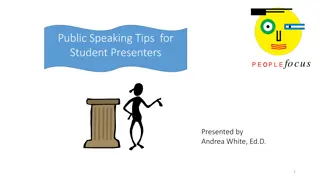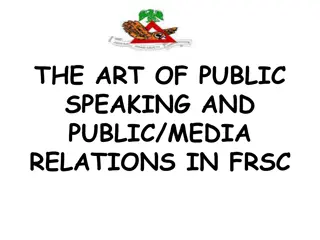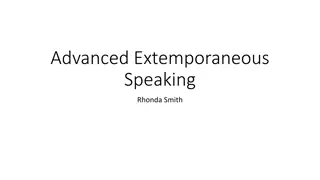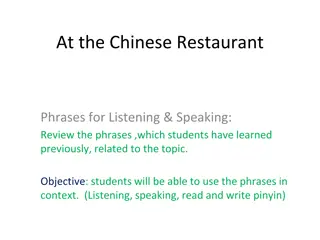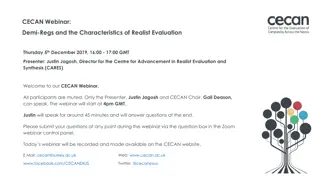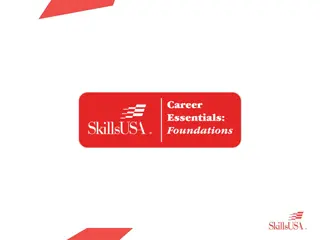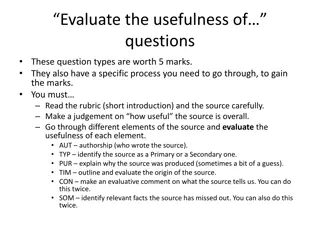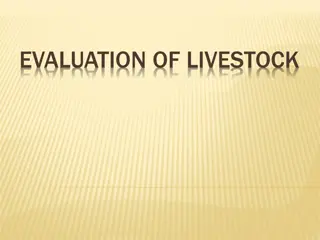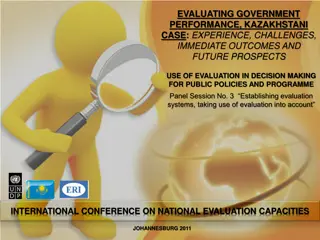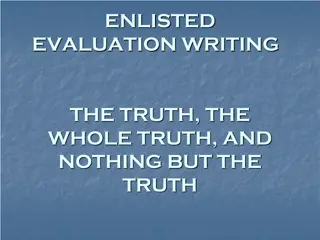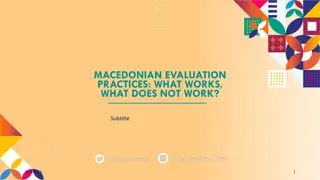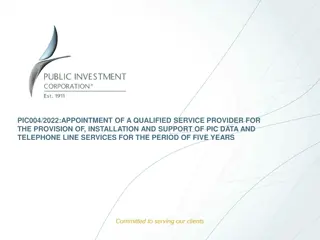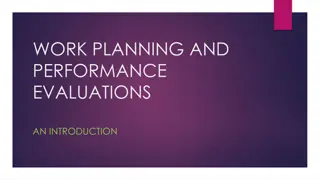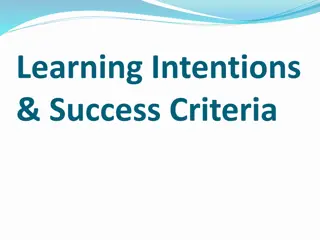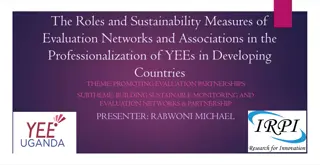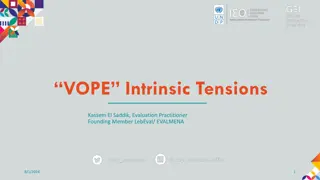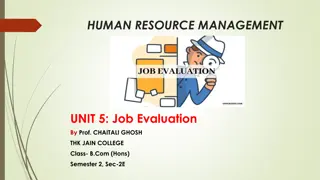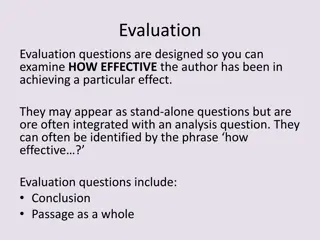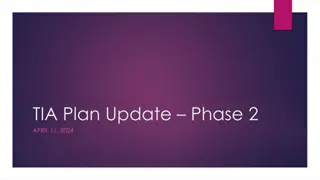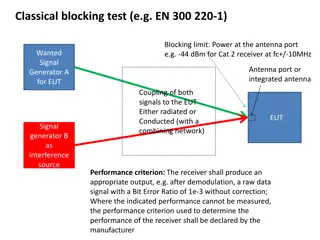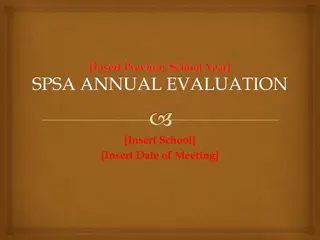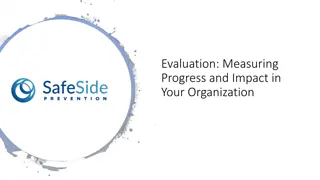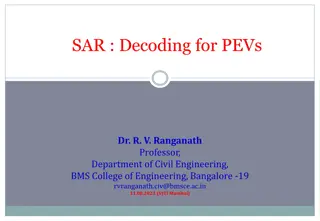Mastering Extempore Speaking: Tips and Evaluation Criteria
Extempore speaking is a performance done without preparation, requiring clear structure and effective communication skills. Conducting Extempore involves picking a topic randomly and speaking on it briefly, following specific evaluation criteria like preparation, content, organization, eye contact, and vocal delivery.
Download Presentation

Please find below an Image/Link to download the presentation.
The content on the website is provided AS IS for your information and personal use only. It may not be sold, licensed, or shared on other websites without obtaining consent from the author. Download presentation by click this link. If you encounter any issues during the download, it is possible that the publisher has removed the file from their server.
E N D
Presentation Transcript
CONTENTS What does extempore mean? Conducting Extempore Structuring with 2Ts Rubrics Tips Merits Watchdogs Example
What does extempore mean? Extempore is a stage performance which is carried out without preparation of any kind. Extempore speaking is the term used for a nonformal speech. The other commonly used names for extempore are impromptu speaking improvised speaking and extemporaneous speaking.
Conducting Extempore Students are required : To pick any card and speak for a couple of minutes on the topic The topics may be repeated for different participants. The performance will be evaluated in terms of specific standards set . Include the clarity and completeness of the speech. The quality of presentation in explaining the topic, as stated in the rubric .
Structuring your speech with 2Ts (a) T elling the audience what you are going to tell them (b) T elling within the time frame.( 2 3 minutes)
EXTEMPORE: CRITERIA FOR JUDGEMENT(Rubrics) Excellent 5 pts Very Good 4 pts Fair 3 pts Average 2 pts Preparation Excellent Very Good Fair Average Clever attention-getting introduction with a clear indication of the thesis and major points to be discussed. Introduction orients the audience to topic and theme, but is not engaging. The audience has an idea of what is to follow. Very Good Introduction establishes the topic or the theme but not both. Not attention-getting. Introduction does not grab attention. There is not an easily identifiable thesis or idea of the major points to be discussed. Average Content/ Presence of mind Excellent Fair Demontrates complete understanding of topic and uses effective transitions. Support material displays original, relevant, and logical thought. Excellent Demonstrates a clear understanding of the topic. Generally effective transitions but support material lacks in originality, relevancy and/or thought. Very Good Content is accurate, but does not demonstrate depth,development, or complete understanding. Little or no grasp of the information. Support material may be inaccurate, inappro-priate, and/or too general. Organization Fair Average Thoughts are clearly organized, developed, and supported to achieve the purpose. Transitions are effectively utilized to create a smooth transition from point to point. Excellent Ideas flow smoothly from introduction to conclusion. Transitions are generally effective. Logical progression of thoughts, but transitions are awkward. An attempt at structure is present, but can be illogical or inconsistent. There appears to be no clear structure of thoughts. Ideas lack direction. Transitions are awkward and/or non-existent. Eye Contact Very Good Fair Average Speaker rarely refers to notes. Makes sustained eye contact with all members of the audience. Speaker maintains inconsistent eye contact with the audience or focuses on one person/part of the audience, ignoring the rest. Speaker frequently refers to notes and makes little eye contact with the audience. Speaker reads the speech and/or rarely looks at the audience, if at all. Vocal Delivery Excellent Very Good Fair Average Excellent vocal expression including appropriate variance in volume, pitch, and rate. Enthusiastic about topic. Good vocal expression including appropriate volume, pitch, and rate. Some vocal expression, but lacking in enthusiasm, volume, pitch, and/or rate. Monotone and/or mumbling. Not effective in maintaining the audience's attention. Lacking in enthusiasm.
Tips Prepare ahead of time by reading a lot about current events. Stick to the topic. Mind Mapping Have an opening paragraph. Try to have something pithy as your first line to get the attention of audience. Conclude by summarizing the topic .
Merits Builds confidence Enhances communication skills Removes stage fear Develops leadership skill
Watchdogs: Avoid speaking too much. Limit to four points. Hammer them home. The first two or three points should add up to the last point.
Example For Extempore Red or Blue? The colors red and blue remind me of the corporate cola giants- Coke and Pepsi; while Coke has a dominant splash of red in its promotional campaigns, Pepsi connects with its customers through a brilliance of blue. Taking this corporate warfare ahead is the example of Jet Airways (blue) and Kingfisher (red), where the latter was a strong challenger to the long drawn supremacy of Jet Airways in the private aviation sector. Furthermore, it reminds me of this wonderful book authored by John Gray, "Men are from Mars, Women are from Venus", where men and women are two diametrically opposite species in terms of their sensitivity levels, behavioral patterns and temperamental differences. However, looking at the topic from another angle is the coexistence of red and blue in the "VIBGYOR" spectrum to make white light, which is the essence of life....


